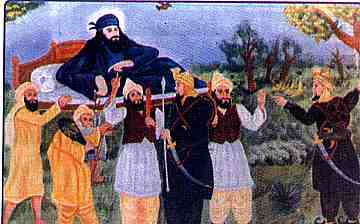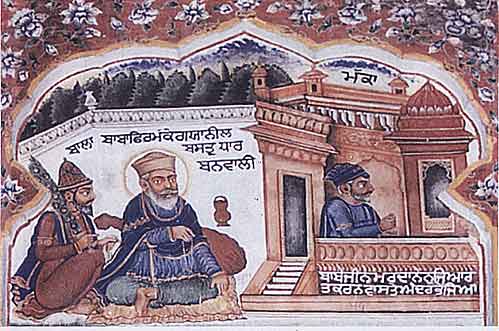
From KOT KAPURA TO DHILLVAN
Dhillvan is a village located near Kot Kapura. When Guru Gobind Singh went to that village he came to know that a large number of Sodhis of the family of Kaul Ji, who was descendent of Prithi Chand, the eldest brother of his great grandfather (Guru Arjan Dev), had settled there. Kaul Ji had four sons, Satta Nand, Har Nand, Amrik Rai and Banwali. Banwali's son, Abhai Ram, was very virtuous. He too had four sons, Sri Ram, Praja Pat, Sri Ram Kuar and Jaspat. On hearing about the Guru's arrival in their village, they all came to see him, along with Kaul Ji. Thc Guru welcomed them and met them with open arms.
Kaul Ji expressed sorrow at the destruction of the city of Anandpur and the martyrdom of the Guru's four sons. He also enquired about Kapura's welfare as he was Kaul Ji's follower. The Guru told him all what had transpired at Kot Kapura and said, "Kapura, who is an agent and a sycophant of the Mughals, had been virtually rooted out"
. Kaul Ji: "But he is my follower and his roots are in my belly. Whoever wants to destroy him will first have to tear my belly". Guru Ji replied "Kaul Ji, if he is after tearing your belly, you yourself will be eager to destroy him."
This conversation filled Kaul Ji with anxiety as he knew that Guru Ji's words, like Lord Rama's arrows, were bound to hit the target. He did not pursue this point further and went home, along with his family, in a subdued and sorrow-ful mood. He spent whole of the night in anxiety. On the following day, after completing his morning prayers, he came again and presented to the Guru a set of new white dress. He asked the Guru to give up wearing blue-coloured clothes and change over to white. The Guru agreed. He tore off the blue clothes bit by bit and threw the pieces in the fire lit up in front of him, in the presence of Kaul Ji.* (According to 'Suraj Prakasli" (Ain 1, Ansu 5), the Guru kept back one small piece of blue cloth which he stuck up with his dagger as an indication that such clothes were worn by the Guru. The Nihangs continue to follow that practice by always wearing blue clothes).
Everytime he threw a piece in fire; he recited the following words:
"nIl bsqR lY kpVy PwVy qurk pTwxI Aml igAw" (The blue clothes have been torn and the practice of the Turks and the Pathans has ended)
(The actual words of the Assa-d-Vaar are "nIl bsqR lY kpVy pihry qurk pTwxI Aml kIAw"= The (people) started wearing blue clothes and started practicing the ways of the Turks (Muslims))
. Kaul Ji enquired as to why that change in Guru Nanak's bani had been made when the precedence of Ram Rai's excommunication from Guruship for changing one word of gurbani from 'mussulman to beimann' before Aurangzeb was there. The Guru replied as follows,
"Kaul Ji, the world knows about the intention of Ram Rai. He wanted to increase his income and gain the good-will of the emperor. I have not done so to please anyone, nor have I made or suggested any written amendment.. The Mughals had ruled over the country in this dress for gene-rations on account of Guru Nanak's blessings given to Babar. But they have committed untold atrocities on innocent people and have tried to destroy Hindu religion. They have gone beyond all limits. Now, by saying so and by offering the martyrdom of my entire family, I have uprooted the Mughal rule from the land and protected Hindu dharma."
He continued. "It had also become necessary to do so for the reason that the Mughals have not been taking sin as a sin but as an Islamic virtue. They use God's Name to deceive others and show themselves as the faithful.
Kaul Ji was pleased to hear such views from the Guru's mouth. He thought that the Guru alone who had sacrificed his all for the protection of righteousness and the weak, innocent people could say so, and as such the whole world should be grateful to him.
Thinking Kaul Ji to be a reliable Sodhi of high spiritual attainment, the Guru gave him some memorable small arms of his own outfit to be kept in safe custody. Thereafter, he gave blessings to all and leaving Dhillvan took to his further journey.
Attire of Kalyuga!
In the sixty first sakhi of the Sau Sakhi, there is this episode about Kalyuga meeting with Guru Nanak, which is as under:-
"Once early in the morning Kaliyuga manifested himself far away from the city, in a terrible form for the sight of Guru Nanak (as recorded in the Janam Sakhi). He had his naked organ of procreation in one hand and the tasteful tongue in the other; he had blue garments on his body."
(text taken from "Sikh Predictions" by Dr, S.S.Kohli -page94)
On page 209 of the "The Sikh Religion" by Max Arthur Macauliffe, the following paragraph solidifies the above claim:-
"The Guru heard that Wazir Khan's army was now in hot pursuit. He accordingly set out from Kapura, and sought shelter in Dhilwan, a village about four miles to the south-east of it. There Prithi Chand's descendents had been settled for some time. One of them called Kaul, now a very old man, visited the Guru and made him a present of a suit of clothes. Upon this the Guru threw off and burned the greater part of the blue dress which he had been using for disguise. In the Assa ki War occurs the line:-
'Nil bastar le kapre pahire Turk Pathani amal kiya'.(The Turks an Pathans put on blue clothes and reigned.)
For this the Guru read:-
'Nil bastar le kapre phare; Turk Pathani amal gaya. (I have torn the blue clothes which I wore; the rule of the Turks and Pathans is at an end.)
The Guru meant the alteration as a curse on the Turks and Pathans. It was deemed an impious act to alter any part of the Granth Sahib. This the Guru did not deny, but said he hoped that the murder of his father and of his own children and the grievous sufferings of his Sikhs were a sufficient atonement. A piece of his blue clothes which the Guru did not consign to the fire he preserved in memory of his troubles. It is said to have subsequently suggested the blue dress of the Akalis or Nihangs.
The following mural and text has been taken with thanks from "Guru Nanak Devji & Sikh History in Murals" by Sohan Singh Khalsaji.

MECCA: Guru Nanak arrived in Mecca, dressed in Navy-blue dress (Neel Bastar) with Bala and Mardana. In the picture Nanak and Bala are having discourses while Mardana is having Ziarat (prayers) inside Mecca. All three are dressed in blue, the colour in which the Fourth Veda was wrapped when brought by Krishna from under the throne of Indra which upon being thrown to earth, is the Ka'aba (by Kahan-nabi). The stool on which Indra rested his feet is also in North Saudi Arabia, a less known shrine. Thus, Nanak dressed in Neela Bana: Neel Bastar lai kaprey pahirey, Turk -pathani amal kiya (adorned navy-blue dress adopting Turki form). Later, as the Tenth Nanak (Guru Gobind Singh), discarded it by saying: Neel bastar lai kaprey faare, Turk pathani amal giya (adorned blue-attire torn, discarding the Turk Pathani form). Out of this form the NIHANG sect originated.